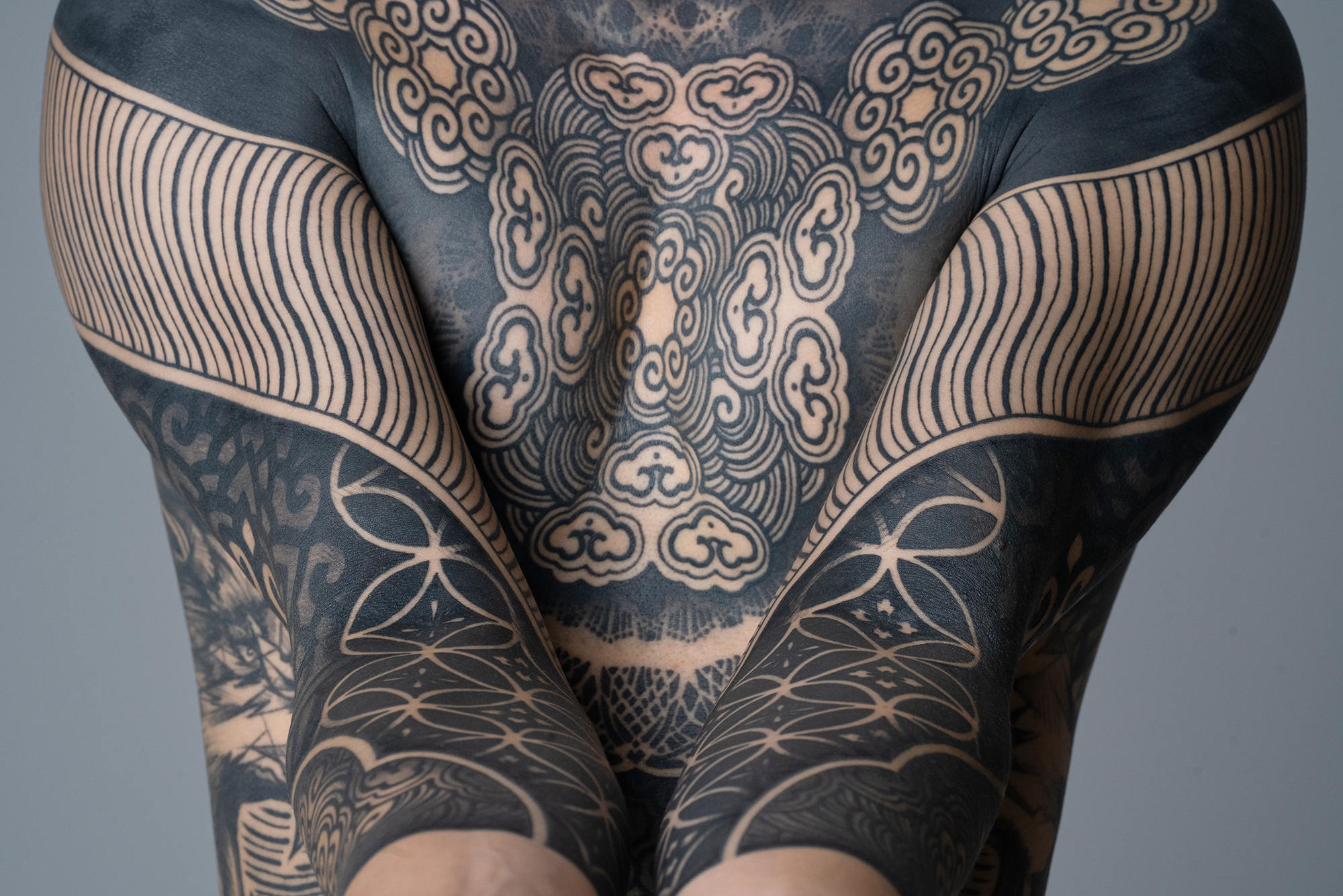
“A tattoo comes alive, when a body moves,” says Ian Damien, a resident artist at Shane Tan’s Singapore studio Feather Cloud. Damien began tattooing approximately five years ago and completed a two-year apprenticeship to enter the profession; however, Tan has been mentoring Damien on the flow and technical aspects of tattooing since he was invited to join Tan’s crew in January 2022. Damien quickly progressed from creating ornate pieces to constructing bodysuits, traveling to Europe for guest spots, and publishing a book of his work within a brief time frame.
Although this interview focuses on Ian Damien’s completed blackwork sleeves and more, he also uses color. He frequently employs ingenious Asian-inspired decorations and arrangements.
Above: This torso artwork is noteworthy because of the use of subtle textures and dynamic patterns.
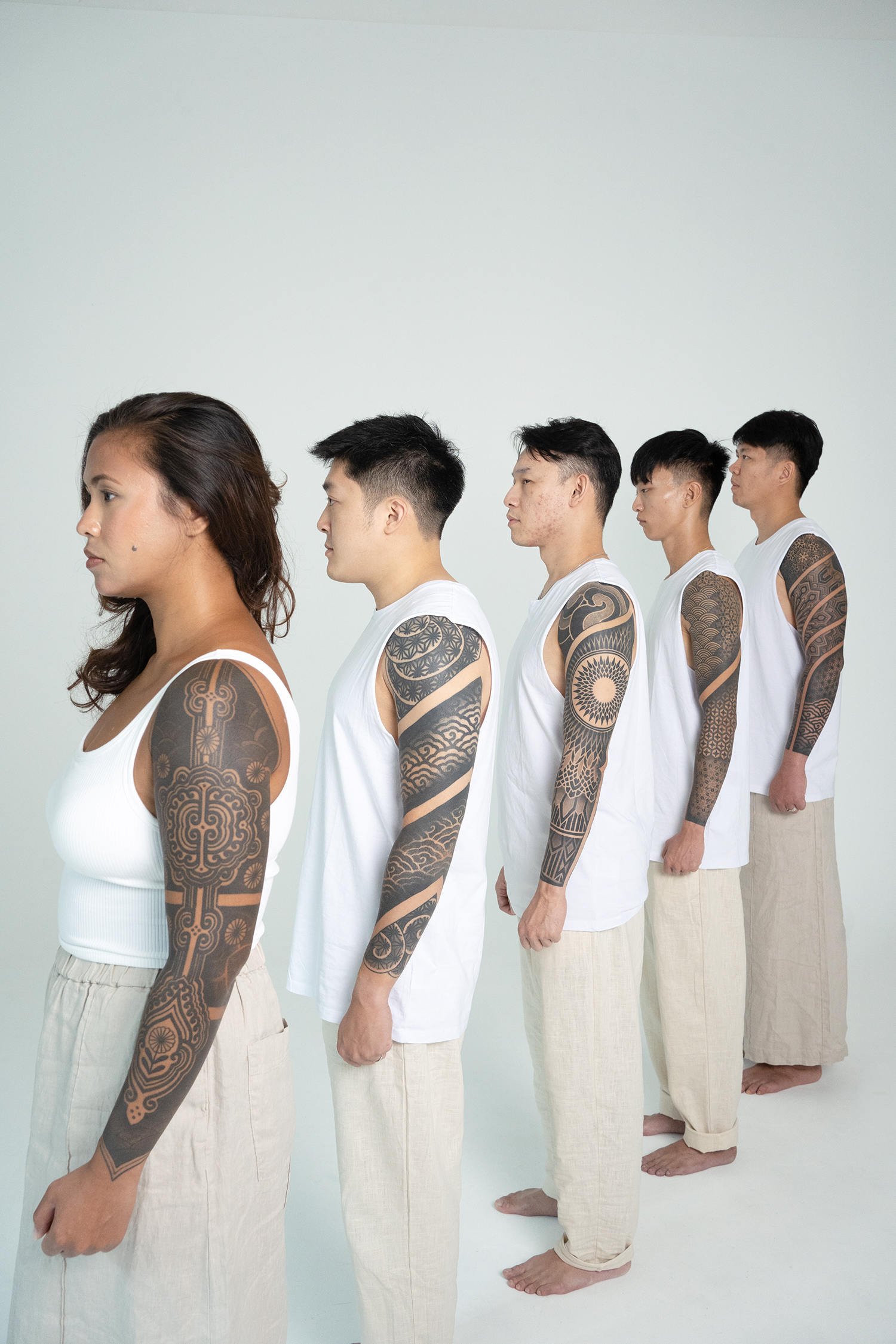
The dazzling geometric and ornamental fusion tattoo sleeves by Ian Damien.
Please describe your childhood and family.
I was born into a conservative and traditional Chinese family. Although not religiously strict, I was raised at temples quite a bit. My parents have Buddhist beliefs, and I used to go and pray with them occasionally at a few temples we frequented. From a young age, I was surrounded by many East Asian art. Temple walls are always impressively and ornately decorated with incredible paintings and carvings. Until today I always find myself most excited when visiting temples abroad. My parents, who at some point worked in various international companies, frequently took my brothers and me on vacations around the continent. I was fortunate to be able to visit much of Asia, and I quickly fell in love with Thai, Japanese, and Korean folk art and architecture. My entire family, being conservative, was against my obsession with tattoos (which began when I was 11). Maybe it was a youthful rebellion that gave me the initial push to discover more about this crazy world that existed beneath what I saw on the internet and television.
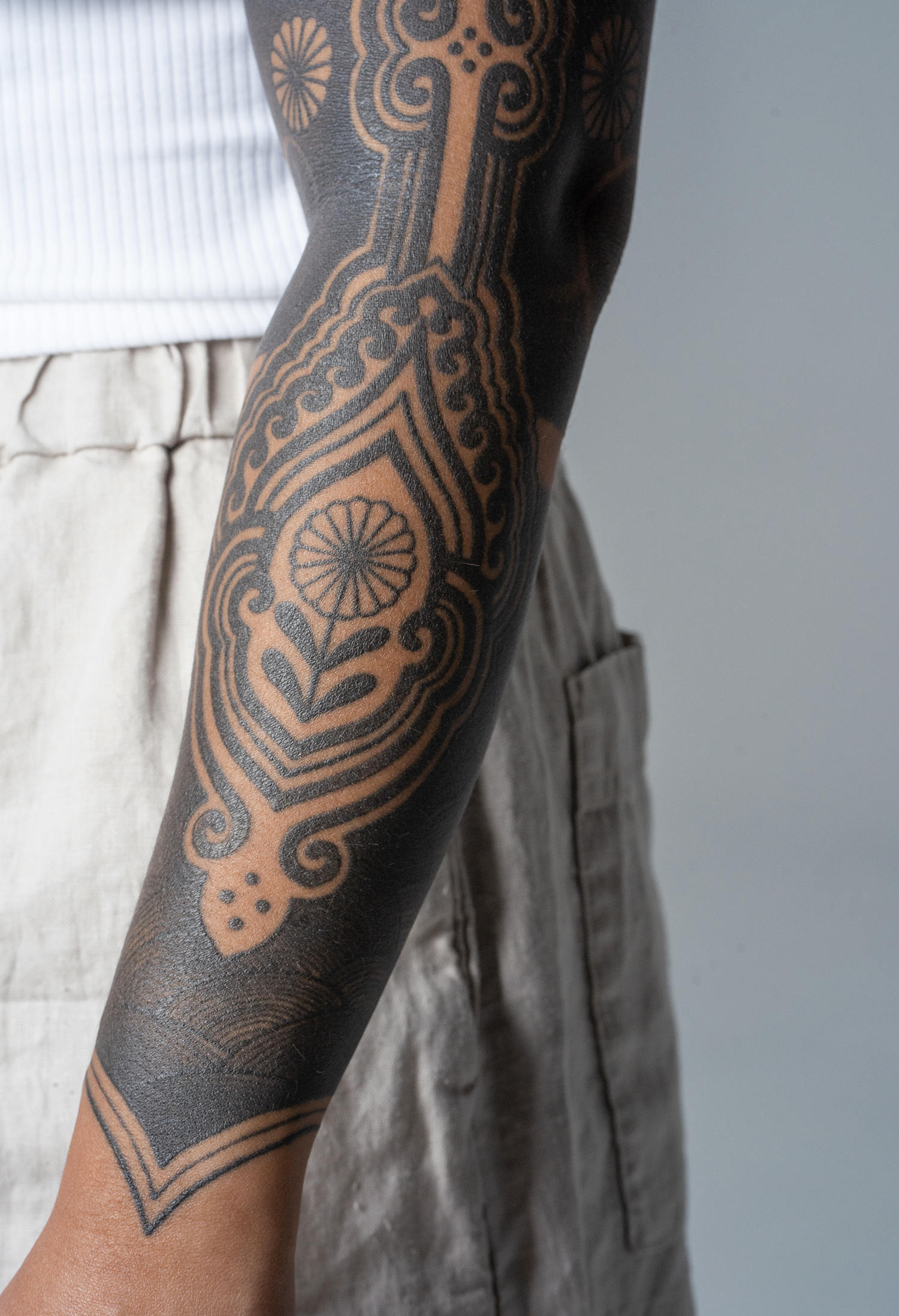
A part of a tattooed sleeve detail emanates exquisite beauty up close.
Did you attend a university? If so, what was your specific area of interest?
In addition to art, I also had an obsession with science. For most of my life, I had intended to be a researcher. I had a diploma in biomedical science and went on to study biology at university. Science and tattooing come hand in hand. Much of the tattooing is very left brain. There is a lot of engineering behind the tattoo machine and immunology in the healing/aging of tattoos. A friend of mine, when watching me freehand, has even commented that my work has an analytical aspect to it. I have to agree. I am naturally attracted to order and neatness. I stayed for four years at university, juggling my apprenticeship during the last two years. I dropped out a few months before graduation, as I could not juggle the stress of the education system and how damn tricky tattooing was, especially at the beginning. A Confucian saying goes: He who chases two hares catches neither.
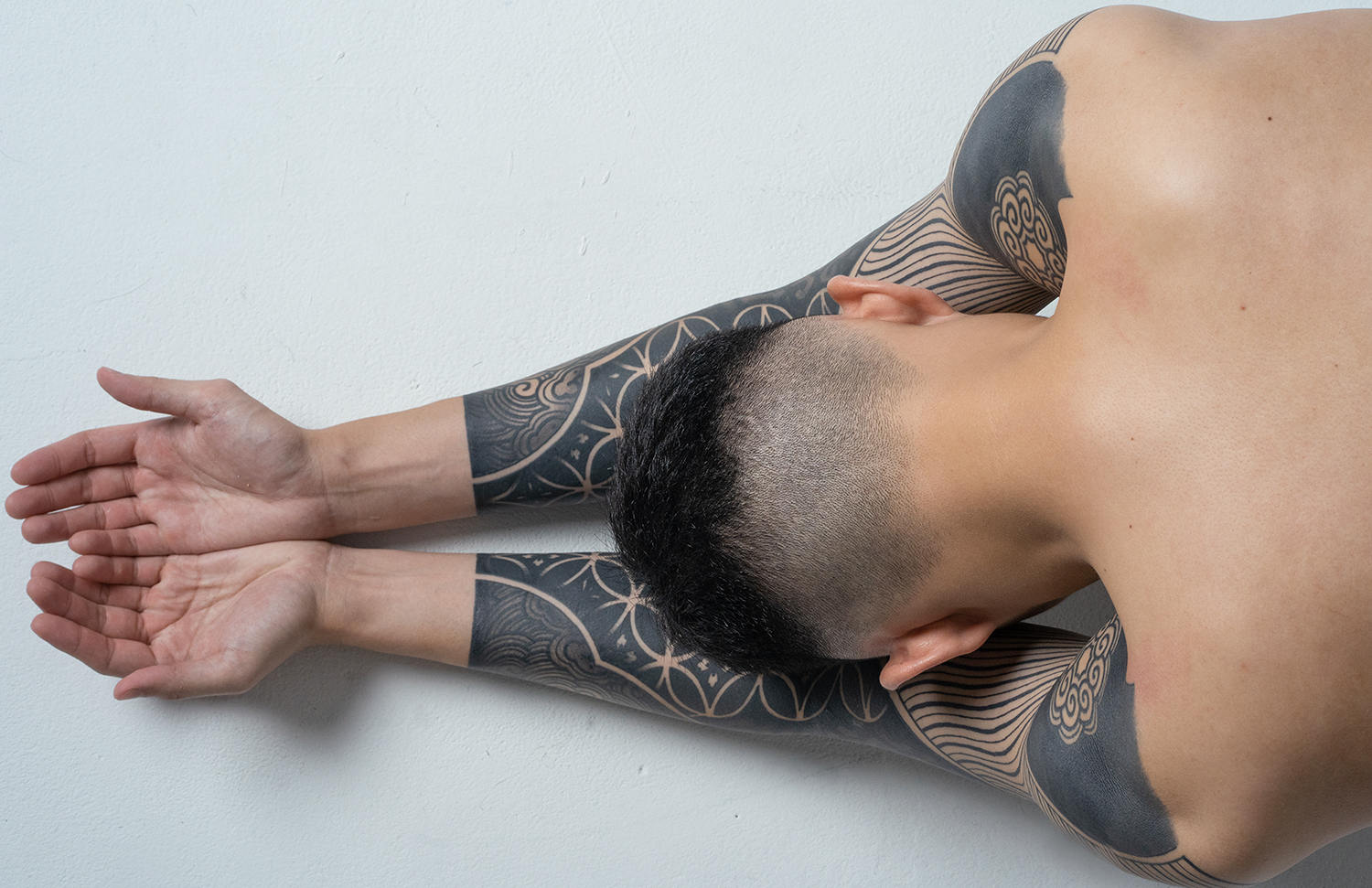
The power and sacredness of tattoo art.
What sparked your fascination with blackwork?
For the first five years of my career, I travelled a lot to neighbouring countries in Southeast Asia. In Borneo, I saw traditional Iban hand tattooing; I was mesmerised by that and felt like I had seen a new side to tattooing. Before that, I only knew Japanese tattooing (which is huge in Singapore). It is difficult to explain why we love one thing in particular, but I remember sitting in my hotel room alone, trying to find more visual material for tribalistic tattooing. I began seeking more tattooing done by ancient methods and chanced upon a documentary [“Patterns of Life”] by Lars Krutak. Soon after, I discovered Thai motifs in the works of Pepe Vicio and Indian Mehndi motifs in Guy Le’s work. Apro Lee’s use of Korean motifs in bold blackwork style also changed my understanding of how strong tattooing could look. I began seeing tattooing as more than just images on the skin, but also a relationship between what is tattooed and what is not. I’ve always loved all kinds of tattooing, but these shook my core for some reason.
As time passed, I dug more and discovered the works of Nazareno Tubaro (aka Xnazax), Thomas Hooper, Tomas Tomas, Leo Zulueta, Xed Le Head, Andreas “Curly” Moore, Jondix, and Hanumantra. In their work, a specific modernistic interpretation of what is ancient felt incredibly humbling. I realised I thoroughly admired and respected individuals who pay homage to a particular culture and create something unique from their own experiences. I decided to try and create a look that had Neo-Tribal roots. I used motifs I had seen in person to make it feel more like me.
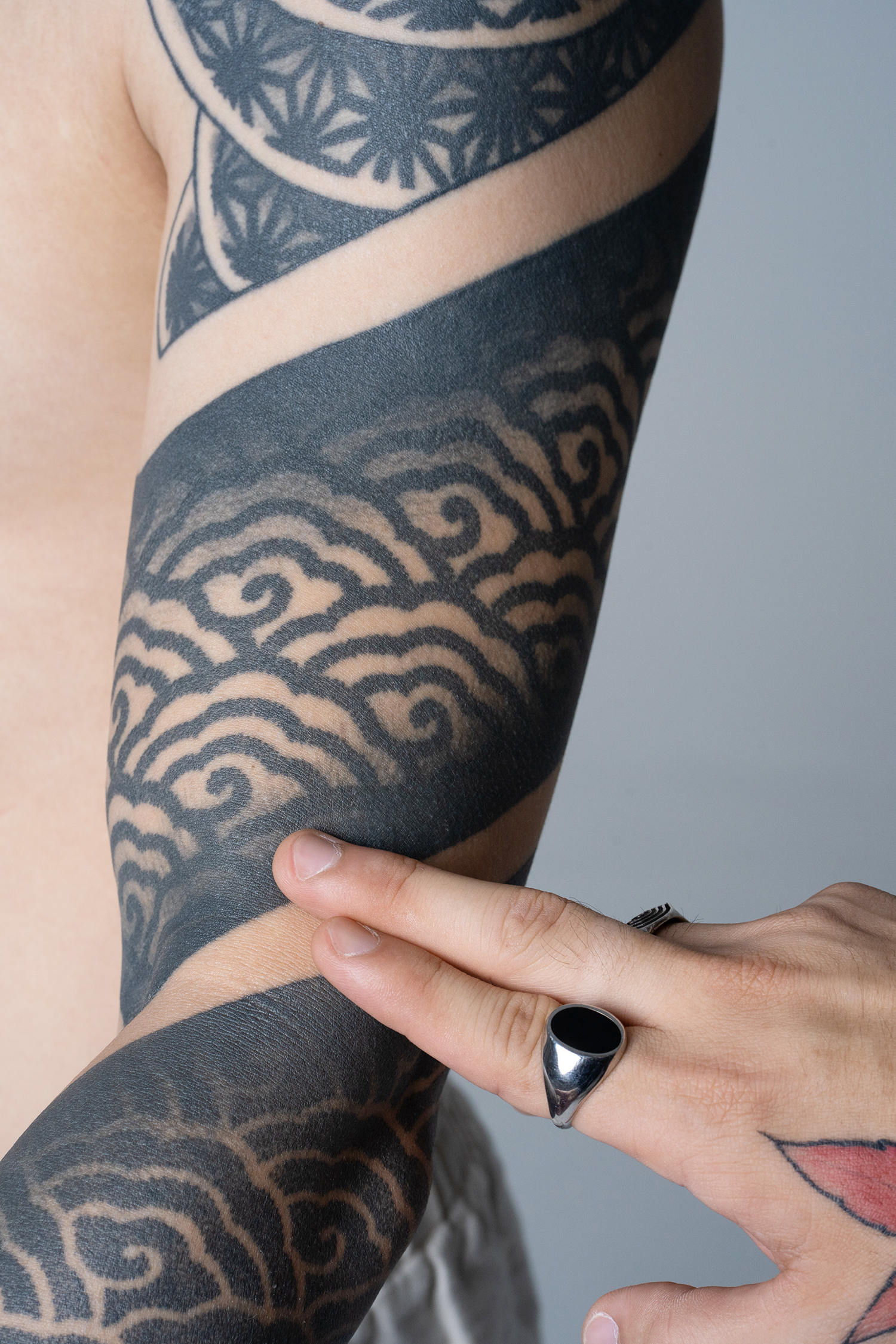
Over the pattern work are mood- and form-creating gradients.
Who or what else has impacted your work other than the blackwork heroes you named?
My work has some Chinese and Japanese essence, and Shane Tan and Horikyo are inspirations in that direction. Their works’ strength, boldness, and unapologetic audacity are genuinely inspiring. People aside, I am most influenced (again) by Asia’s textiles, folk art, and architecture. I am Singaporean and, therefore, a product of this country’s cultural melting pot. Singapore takes things from everywhere and creates a voice with evident roots. My work is a little like that. The challenge is to create something authentic, respectful, and visually cohesive. My work has many long straight lines, which come from the grid-like anti-form compositions of tattooing from the South Pacific islands. I love the idea that strength and rigidity can be composed so elegantly onto a flowing form like the body.
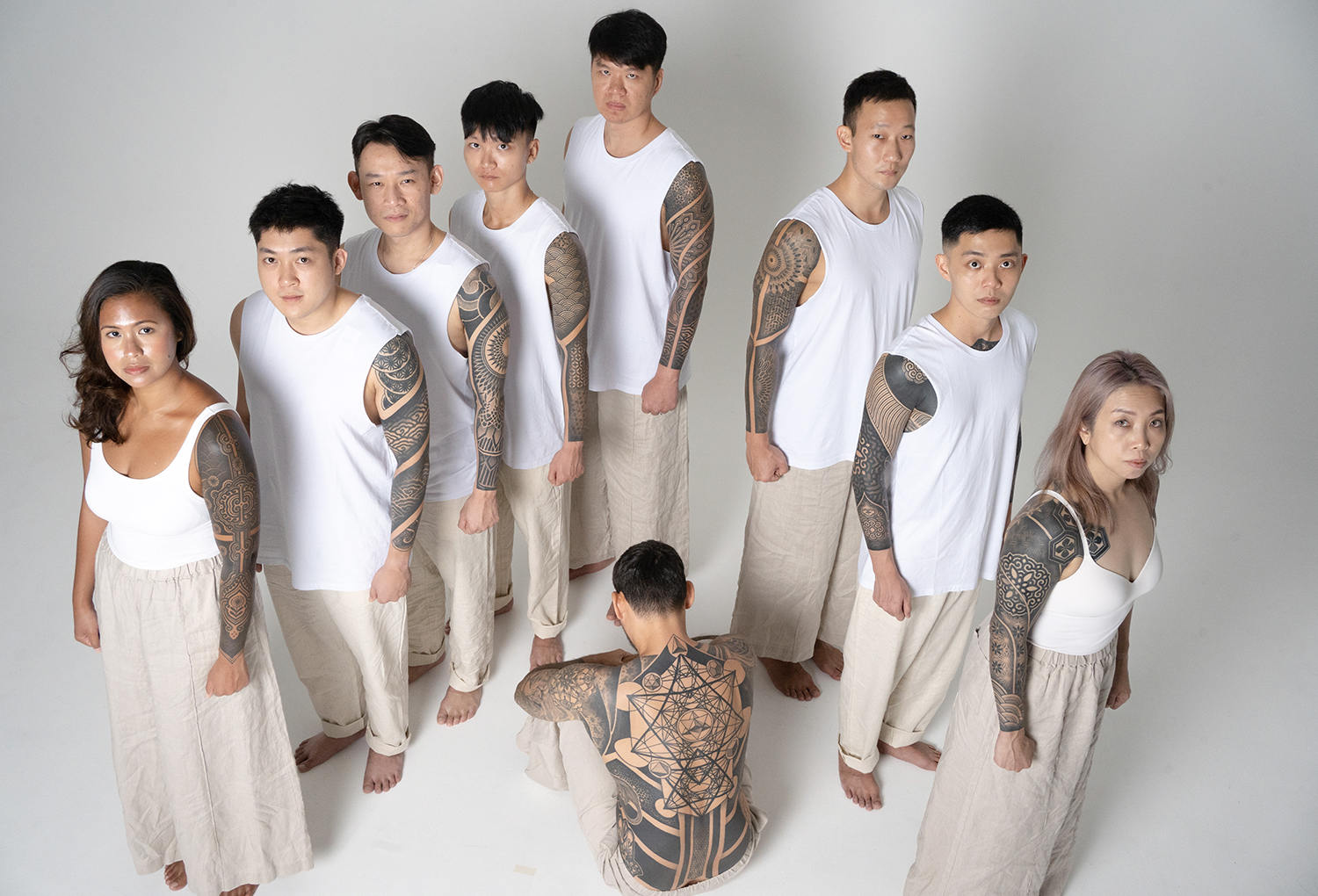
A collection of Damien’s black-ink art.
Discuss your grid technique that is directly drawn on the body.
The gridding of the body is something I first saw when I discovered Kenji Alucky’s work. With a little more digging, I later came to find out that Xed Le Head, too, practised that concept. Gridding is meticulous but very rewarding. I am very attracted to disciplined repetition. It’s an excellent way for me to combine the idea of tailoring something to the individual and overcoming many stenciling problems that can arise from areas of the body that are difficult to stencil. These are the pros and cons, but I don’t feel they influence my decision to specific freehand patterns.
In addition, many are fascinated by watching how mathematics and the correct combination of lines create a complex harmony. From a functional standpoint, having dense linework in one area allows me to create a space that contrasts negative space and flat black. It’s a beautiful and versatile intermediate. Think of it as a parallel to grey shading in the tattoo, adding a data point to a linear range of tones.
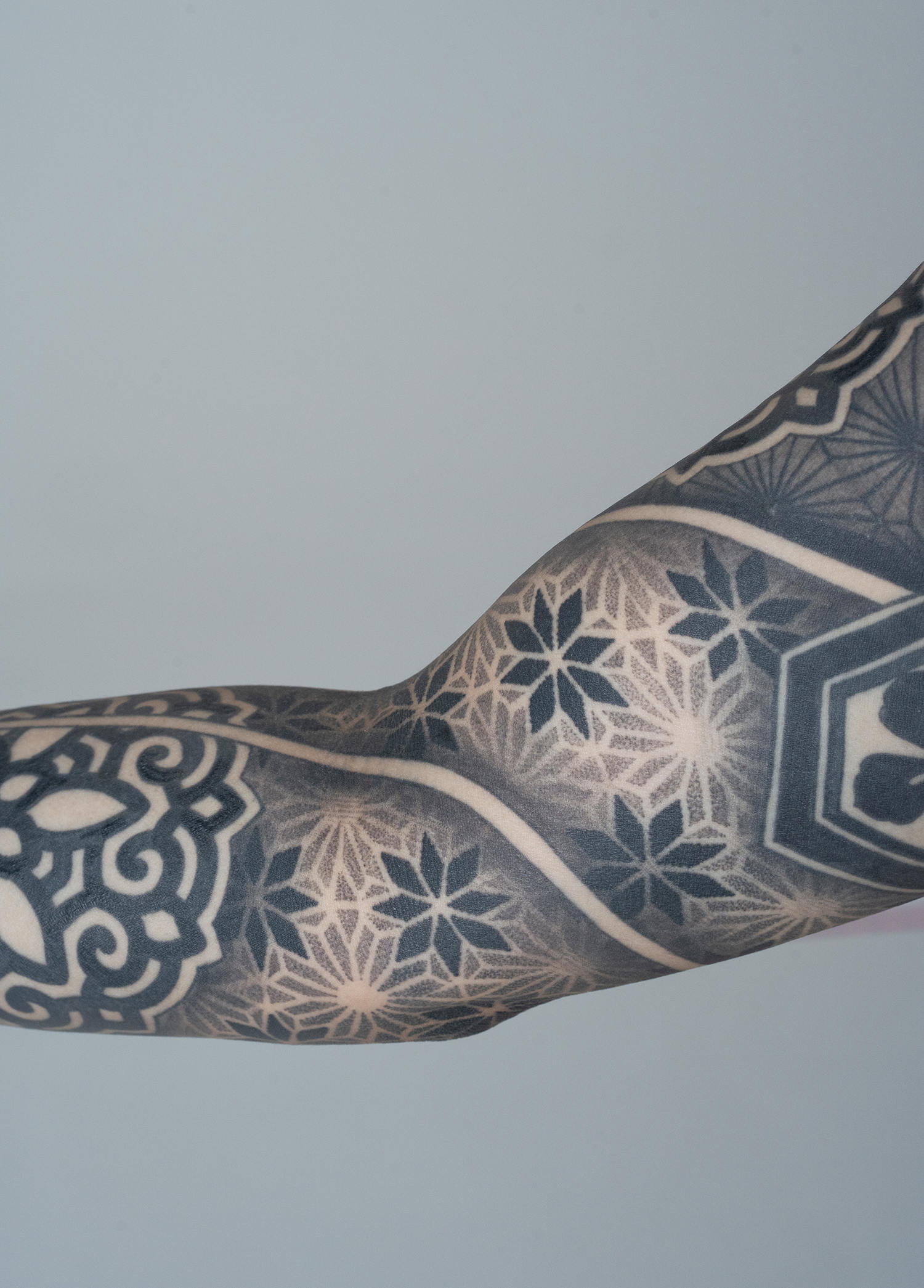
Damien enjoys the texture of stippling, which is also a nod to tribal tattooing.
Why do you believe Shane Tan selected you to join his studio, Feather Cloud?
Honestly, it beats me. I want to think that it’s because I view tattooing similarly to Shane. Shane considers tattooing with obsessive passion; nothing else matters; no material possessions to chase, no social status to attain, no bullshit to present. Shane is about making a decent tattoo and travelling to meet other people who want to do cool shit as well. I resonate with that.
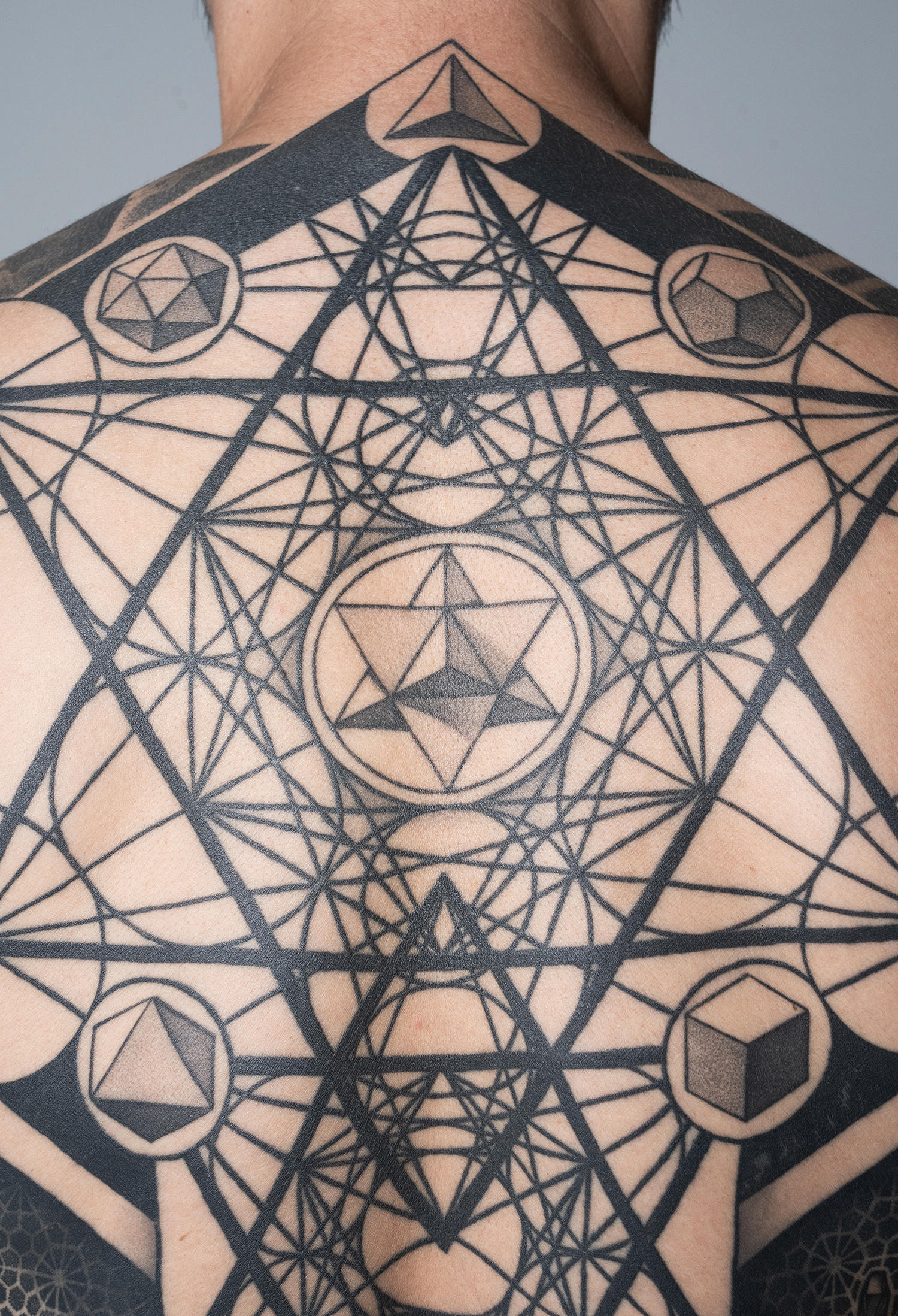
The intricate layering of geometric motifs on the back tattoo.
Shane Tan has been your mentor, even though you already knew how to tattoo.
What are the main aspects in which he is assisting you?
Shane is an incredible mentor and one of my dearest friends. The love he has given me is only outclassed by the immense wealth of knowledge he has shared with the Feather Cloud family under him. Over decades of pure unobstructed obsession and an absurd amount of globetrotting, Shane gathered knowledge. He constantly sheds light on the very technical aspects of tattooing. Shane was from the generation of Singapore tattooing that soldered their needles. When you are responsible for every component of a tattoo, needle, and ink upwards, you learn how microscopic differences contribute to a vast variance in the end product. How a machine hits, how the skin reacts to different inks/needles, etc. We discussed the chemical components of certain numbing creams and how they can affect vascularity and bleeding, which is a significant component in healing a tattoo.
In addition, Shane is an avid collector of rare tattooing books. I’ve been so lucky to see images lost to history and unavailable on the internet; Japanese mythology, tattooing history, and sheer amounts of reference material. He shares and gives endlessly. I’ve been at Feather Cloud for a year and have yet to hear information repeated twice!
My work is compositional and form-flowing and draws major influence from Japanese tattooing. I do not do traditional Japanese tattooing, but there are many parallels between that and my work. Every day I watch a bodysuit being constructed, and I slowly begin to dissect the process inch by inch, from drawing the subject matter to composing supporting elements, tonal distribution, foresight, and readability. I doubt I’ll ever achieve mastery like Shane, but it is cool to watch.
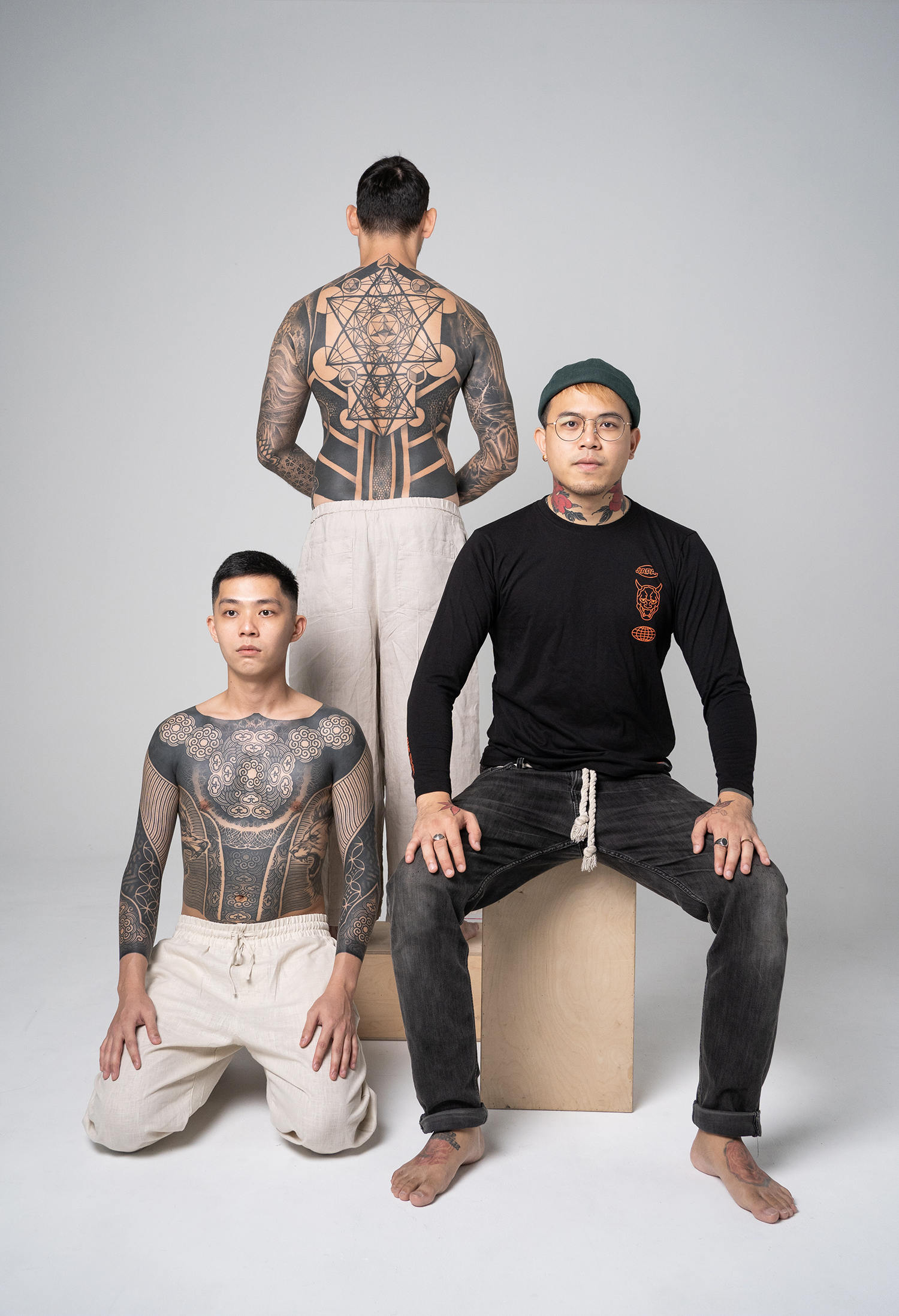
The artist Ian Damien (right), alongside his tattooed clients.
You just returned after a long journey to Europe and guest spots. Was this your first visit to Europe?
It was incredible! I’ve always been slightly intimidated by stepping out of Asia. I am so glad I did. Getting to meet my heroes in the flesh was just something else. At the heart of it all, I’m just a humble fan of tattooing. The people I guested with are Titans [Nazareno Tubaro, Jondix, and Hanumantra]. They paved the way for my generation to walk.
I’ve barely scratched the surface of Europe; however, it feels that tattooing there are decades ahead of Singapore. That being said, we’re a young country with incredible talent, and I’m excited to see the inevitable growth of Singaporean tattooing!
Photos © George Bates
